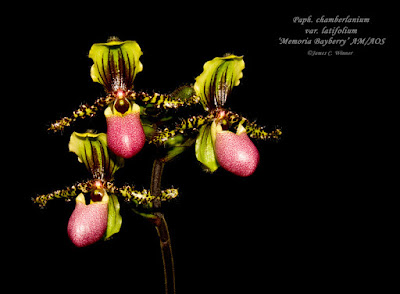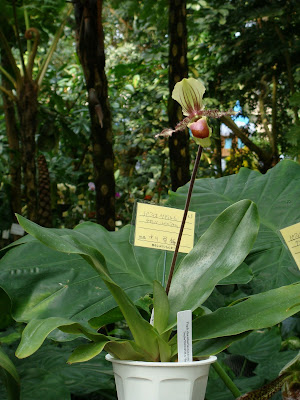Chamberlain's Paphiopedilum is native to Sumatra. They occur in the central part of western Sumatra at an altitude of 800-1600 m above sea level. They grow in the leafy jungle of the foothills of the jungle and on the western sides of limestone rocks. The roots are buried in moss growing on the watercourses and natural depressions, which provides almost continuous access to water.
Paphiopedilum chamberlainianum orchid, also called as Chamberlain's Paphiopedilum, Cordula chamberlainiana, Cypripedium chamberlainianum, Paphiopedilum chamberlainianum var. latifolium, Paphiopedilum victoria-regina subsp. chamberlainianum, Paphiopedilum victoria-regina var. latifolium, is a species of the genus Paphiopedilum. This species was first described by (O'Brien) Pfitzer in 1895.
IDENTIFY PAPHIOPEDILUM CHAMBERLAINIANUM ORCHID
Chamberlain's Paphiopedilum is native to Sumatra. They occur in the central part of western Sumatra at an altitude of 800-1600 m above sea level. They grow in the leafy jungle of the foothills of the jungle and on the western sides of limestone rocks. The roots are buried in moss growing on the watercourses and natural depressions, which provides almost continuous access to water.
It is a small to medium sized, cool to cold growing lithophytic orchid with a leaf span of up to 90 cm. A rather short stem is surrounded by longitudinally overlapping leaves. The leaves are obtuse, narrow, oblong-elliptic, fawn green with lighter chess spots, 45 cm in length and 10 cm in width. The green underside of the leaf is covered with a larger or smaller number of small purple spots.
It can bloom through out the year and has a terminal, erect, to 60cm long, 4 to 8 flowered inflorescence with the flowers produced successively over a long period of time. The oval shape of the dorsal petal is green or creamy-white, purple at the base, sometimes has narrow brownish, longitudinal stripes. The lateral outer petals are fused to form a green-white, ovoid-shaped lower petal. The flakes are cream-colored, they are covered with large, irregularly shaped purple dots, and their edges are covered with rarely scattered, long, stiff hairs. Densely speckled with purple spots, it has a white border around the upper edge and a pink to red-purple color. The rhomboid shape of the base of the pollen chamber is green with an intense dark chest color.
GROW AND CARE PAPHIOPEDILUM CHAMBERLAINIANUM ORCHID
Cultural information should only be used as a guide, and should be to be adapted to suit you. Your physical location; where you grow your plants, how much time you have to devote to their care, and many other factors, will need to be taken into account. Only then can you decide on the cultural methods that best suit you and your plants.
Light:
Paphiopedilum chamberlainianum orchid need a light source of 15,000-23,000 lux. Moderate bright light is recommended. Strong air movement should be ensured all the time.
Temperature:
Similar throughout the whole year - average temperatures of 23-24 ° C, average night temperatures 16-17 ° C, with an amplitude of daily variations of 7 ° C.
Humidity:
The plant need humidity of 80-85% throughout the year.
Substrate and growing media:
The containers should be filled with a loose, permeable substrate that maintains moisture but does not absorb. Paphiopedilum chamberlainianum can tolerate many different potting mediums. The containers should be regularly rinsed in order to prevent the deposition of mineral salts.
Watering:
Plants should be moist, and between the next watering should only slightly dry out, but must not allow the substrate to be stale or soggy. In winter, the amount of water should be slightly reduced, especially if the plants are grown under dark, short days, which occurs at moderate latitudes. However, do not allow it to completely dry up.
Fertilizer:
Plants should be fertilized every week or every two weeks with 1/10-1/4 of the recommended dose of fertilizer for orchids. The fertilizer with a high nitrogen content with fertilizer with an increased amount of phosphorus should be used alternately throughout the year.
Rest period and repotting:
That plants should undergo a short rest period in order to induce flowering. It is important to remember to repot before the substrate has decomposed and is acidified. Repotting is usually done in late winter or early spring.














COMMENTS